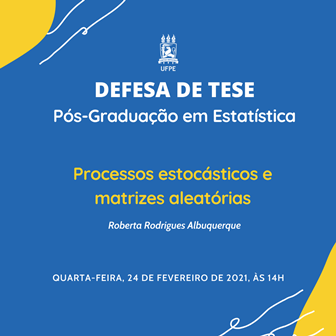Agenda de Defesas
- UFPE/
- Research/Innovation/
- Defense Schedule/
- Programa de Pós-Graduação em Estatística promove defesa de tese intitulada “Processos estocásticos e matrizes aleatórias”
 Events Events
Events Events
Programa de Pós-Graduação em Estatística promove defesa de tese intitulada “Processos estocásticos e matrizes aleatórias”
A defesa é aberta ao público e acontece das 14h às 17h

O Programa de Pós-Graduação em Estatística promove amanhã (24) a defesa de tese de doutorado da pesquisadora Roberta Rodrigues Albuquerque intitulada “Processos estocásticos e matrizes aleatórias”. A defesa é aberta ao público e acontece das 14h às 17h. Para ter acesso à sala virtual é necessário entrar em contato com o orientador e professor do Departamento de Estatística (DE) Raydonal Ospina Martínez. A pesquisa foi escrita em inglês, mas a defesa será em português.
O trabalho teve orientação do Raydonal e coorientação do professor do Departamento de Física (DF) Antônio Murilo Santos Macêdo. Além do coorientador, integram a banca os seguintes membros titulares Alex Ramos, Pablo Martin Rodriguez (DE), Bruno Geraldo Carneiro da Cunha (DF), Cristian Coletti, do Centro de Matemática, Computação e Cognição da Universidade Federal do ABC e os membros suplementes Klaus Vasconcellos (DE) e Giovani Lopes Vasconcelos do Departamento de Física da Universidade Federal do Paraná (UFPR).
Resumo em inglês
The thesis is divided in three main parts. In the first part we consider the Möhle's recursion formula which characterizes the probability distribution of the gene types in a population where the family lines are described as the ¿-coalescent process and mutations are identified as a Poisson process along the family lines. Our main objective is to verify whether Gibbs EPPF is a solution to Möhle's recursion formula. In the second part of the thesis we consider the left invariant vectors fields on the Heisenberg Lie group and a stochastic differential equation which correspond to an hypoelliptic operator. The first purpose is to find out a integration by parts formula on the space of paths using the hypoelliptic measure and the second purpose is to give the Bismut type formula in the hypoelliptic case. In the third part we consider the Gaussian distribution as the conditional and the Wishart distribution as the background and we also would like to consider the product of two Wisharts distributions in the future. To perform the calculations we apply some techniques as the M -transform, the convolution theorem and the Color-flavor transformation. We gave a new proof of the convolution theorem.
Mais informações
Raydonal Ospina Martínez
raydonal.martinez@ufpe.br




